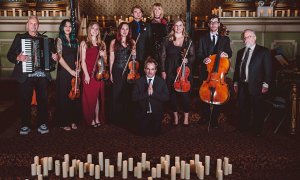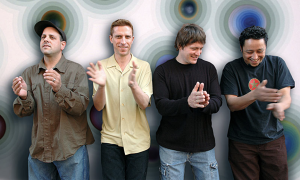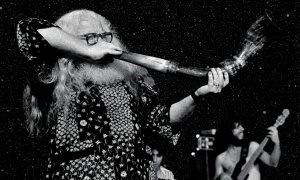Home » Jazz Articles » From the Inside Out » Fusion Groovin’
Fusion Groovin’
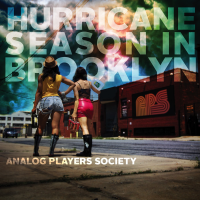 Analog Players Society
Analog Players Society Hurricane Season in Brooklyn
Studio Brooklyn
2012
Hurricane Season in Brooklyn marks the debut of the Analog Players Society (APS), an extension of the lifelong pursuit of the groove by the percussionist, engineer and producer known as Amon, who first discovered Turkish, West African and Middle Eastern music in college—and then dropped out to tour with a circus multi-instrumentalist.
"I eventually moved to Chicago and studied African percussion intensely for four years and traveled to Guinea, West Africa, to study," he recalls. "I eventually studied with Famadou Konate, Mamady Keita and M'Bemba Bangora." Amon's percussive awakening continued through work with DJ Nickodemus and dub legend Lee "Scratch" Perry, and is heard and felt in the vocals, handclaps, breaks and beats in Brooklyn, which Amon completely wrote (except for some lyrics and the cover tunes), arranged, recorded, mixed and produced.
Amon's inventiveness with instrumentation and rhythm is particularly striking in Brooklyn's first two tracks. The opening "Free" is an incredible composition and performance: While drummer Sean "Tricky" Dixon thumps a hip-hop sounding beat—not only a hip-hop rhythm but a hip-hop sound—Jonathan Powell's trumpet icily skates like Miles Davis' atop congas and other percussion popping Afro-Cuban jam; the eventual horn chart simultaneously overlays Afro-beat and jazz (think Basie big band) horns! "Hurricane Season in Brooklyn" projects the hip, edgy sound of Thievery Corporation and trims Cecilia Stalin's lead vocal in edges that suggest Ella Fitzgerald (in her daring, joyous sense of sound) as a space-age disco diva, and closes in thunder that echoes and fades. Both these tunes approach contemporary funk like Stomu Yamashta's Go approached 1970's blues-rock, and are genuinely, organically brilliant.
"Just a Day" wades in the water of a reggae meets jazz vibe led by Stalin's voice, again so sassily swinging that it splashes then melts in your ear like Chaka Khan. In between, and a bit surprisingly, APS surveys and then remodels three popular dance tunes from the 1980s: "Let the Music Play" (Shannon), where Amon translates the vocal melody to dancehall piano and keyboards to glockenspiel; "I Can't Wait" (Nu Shooz); and "Dance Hall Days" (Wang Chung), transformed into a stately reggae instrumental with the horns "singing the chorus" behind Will Jones's sax, slippery and funky like a really good Eddie Harris recording from the 1970s.
"I like capturing the feel of live music in the studio, but playing live with these guys is the best," Amon says. "We all can learn a set in the afternoon and play it that night. I know I can throw anything at them and when we get on the bandstand, it'll be amazing."
 Robert Hurst
Robert Hurst BoB: a palindrome
Bebob Records
2013
The roll call of great bass players from Detroit includes Ron Carter, Paul Chambers and Doug Watkins. Robert Hurst, another Motor City musician, has for the past several years made a compelling case for his name on that list.
Hurst picked up the bass at age 14 and was soon performing with Detroit trumpeter Marcus Belgrave, who had previously been a member of Ray Charles' band. Hurst subsequently met drummer Jeff Tain Watts, who invited the bassist to join him in the rhythm section for the Wynton Marsalis band, where Hurst stayed for three years and seven recordings. Hurst later worked with Wynton's brother Branford Marsalis, including playing in The Tonight Show band under Branford's direction. While working on this Show, Hurst found time to write arrangements and play bass for Willie Nelson, Boyz II Men and Barbra Streisand. He's also served as bassist in Chris Botti's and Diana Krall's touring and recording bands.
Even with all this sidework, BoB: a palindrome is Hurst's sixth CD as a leader, and fourth release on his own Bebob label. It reunites Hurst with trumpeter Belgrave and drummer Watts ("I have been partners in time with Brotha Jeff 'Tain' Watts for nearly 30 years," BoB notes), and adds pianist Robert Glasper, percussionist Adam Rudolph and reed master Bennie Maupin (another Detroit native). Hurst's notes also explain that he prepared each composition like Duke Ellington would—"with the specific tones and particular talents of the musicians in mind."
What you think of BoB may depend upon which parts you hear. Belgrave's flugelhorn sings "Big Queen" (composed by Hurst for his wife Jill) light and soft, while Hurst leads the rhythm section in a dynamic yet singular, unified voice. "Little Queen" (for Hurst's daughter Jillian) sings just as beautifully through Maupin's soprano sax.
"Middle Passage Suite" is a three-part meditation inspired by Middle Passage (Atheneum Publishers, 1990), Charles Johnson's historic novel about the final voyage of a slave ship in 1830. Each part expands in scope and vision, from two to nearly 13 minutes. "Part II: For Those of Us That Didn't Make It" grows from a small brooding piano figure into an exotic, dark sound of percussion, bass and trumpet. Watts quickly detonates the quiet bass solo that opens "Part III: For Those of Us Still Here" into a landslide of tumbling rhythm; Maupin's soprano soars, caught in the updraft of Hurst's tumult. "Middle Passage Suite" writes an adventure as deep and far-out as any Alice Coltrane or Pharoah Sanders travelogue.
BoB's two closing tunes wrestle the jazz-funk monster down: Hurst's bass thrashes and flails "Indiscreet in da Street" like a raging Charles Mingus; the rhythm section plays so strong that it nearly overwhelms this tune, which seems to smolder down to ash as it fades. "Jamming—a.k.a. Ichabod" kicks out an old-school New Orleans funk party, as Hurst's bass and Watts's snare drum stretch their shared pulses out into elastic time, informed by both James Brown and Miles Davis—more accurately, informed by James Brown through Miles Davis. "Jamming" is a powerful ending to a great set.
BoB: a palindrome was actually recorded in 2001, and some tracks were originally written as far back as 1985. Even so, it sounds like it could have been recorded tomorrow.
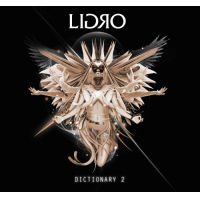 Ligro
Ligro Dictionary 2
MoonJune Records
2012
Recorded in Jakarta (Indonesia) in 2011, Dictionary 2 presents the first international release from one of Indonesia's most acclaimed jazz-rock fusion trios: Drummer/percussionist Gusti Hendy, bassist Adi Darmawan and guitarist Agam Hanzah. (Hendy doubles as a member of Indonesia's pop-rock sensations GIGI.)
Dictionary 2 burns with enough kinetic energy to traverse the entire distance of Ligro's unique "east meets west" jazz-rock guitar fusion, which sounds strongly influenced by Robert Fripp and Bill Bruford, and their progressive guitar and drum work in King Crimson, plus metallic fragments of guitarists John McLaughlin and Jeff Beck. But Dictionary 2 is no historical or musical textbook. Guitarist Hanzah plays as much as each song needs (and sometimes more); with each song a guitar jam, the tunes sort of melt into each other and cumulatively build Dictionary 2 into a guitarist's dream.
Written to honor the departed trumpeter, "Miles Away" kicks a limber groove which Hanzah's guitar spikes upon jagged funk riffs and then slowly turns inside out. Darmawan opens "Stravinsky (with Bach intro)," Ligro's variation on Stravinsky's "An Easy Piece Using Five Notes," with an enchanting solo bass Bach meditation, while Hendy drums with a combination of power and fluidity heard in few drummers other than Bruford.
"Etude Indienne" exhaustively explores Ligro's "east meets west" instrumental horizons: Hanzah's guitar intro casts McLaughlin's style in the sound of grunge before the trio settles into the rhythmic feel of an open rock raga, pulses more than beats, pulses which bubble and crest into waves of melody and rhythm. "Transparansi" opens with a bright, airy percussion and guitar discussion before the trio breaks up the entire structure down to its foundation.
"Future" and "Don Juan" attune more closely to the groove. Ligro's "Future" revels in a biting, edgy sound that flows from blues to progressive jazz-rock without adapting much structure from either. "Don Juan" finally backs off the throttle, and Hanzah chops out guitar chords that settle into a more relaxed and roomy feeling than the compressed, kinetic action throughout the rest of Dictionary 2.
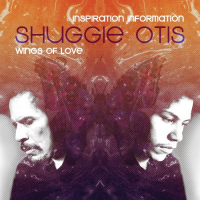 Shuggie Otis
Shuggie Otis Inspiration Information / Wings of Love
Epic/Legacy
2013
Singer, songwriter and multi-instrumentalist Shuggie Otis might not have been born holding a guitar but he probably picked his first one up soon thereafter. He did grow up playing guitar in bands led by his dad Johnny Otis, who introduced such artists as Charles Brown and Esther Phillips to R&B and soul audiences. He debuted in 1970 on Kooper Session: Al Kooper with Shuggie Otis (Columbia); when he recorded those tracks, he was just 15. His solo debut, Here Comes Shuggie Otis (Epic, 1971), produced and arranged by his dad, followed soon thereafter. Inspiration Information (Hi Horse), another mostly solo affair, appeared in 1974 but quietly and quickly fell out of print. The Brothers Johnson strapped Shuggie's "Strawberry Letter #23" into their Quincy Jones-produced album Right on Time (A&M, 1977) and rode it into the stratosphere: The single went #1 Soul, #5 Pop and the album went platinum. But except for some session work with Etta James, Frank Zappa and a few others, this was more or less all we heard from Shuggie Otis.
Although the influence of his bandleader, songwriter, impresario and Rock & Roll Hall of Fame R&B Pioneer father on West Coast blues, rhythm & blues and soul music is impossible to overstate, Shuggie Otis's legend sometimes seems even bigger because, like a comet, he gloriously skyrocketed and then pretty much vanished.
Or at least vanished until 2013, when he personally oversaw the digital restoration of Inspiration Information with four previously unreleased bonus cuts, and its combination with Wings of Love, a collection of previously unreleased live and studio tracks recorded as far back as 1975 and as recently as 2000, into a two-CD set. Combined, these two releases present an expansive survey of soul, jazz, funk, pop, blues and R&B. Inspiration Information often feels like you're submerged and swimming inside Otis' head as he contemplates mid-70s psychedelic soul, especially its title track, "Aht Uh Mi Hed" and "Island Letter," where soft keyboards wash up against wah-wah guitar like waves lapping against a sunny California beach. "Not Available" seems lifted from the Bobby Womack school of cinematic soundtracks, while "Sparkle City" moves more quickly on Otis' funky rhythm guitar and the instrumental "Rainy Day" sounds like one of Creed Taylor's pop productions of guitarist Wes Montgomery. Of the newly released bonus material, "Miss Pretty," a soulful and funky Sly & the Family Stone-type thang, and the slinky "Castle Top Jam," work best.
Wings of Love, entirely made up of previously unreleased music, offers a more mixed grab-bag of chronological snapshots, some of which ("Give Me a Chance," "If You'd Be Mine") sounds like Otis chasing the sound of 1980s pop radio. But his buttery, rubbery bass line helps "Special" sound like one more solid Brothers Johnson groove, and "Walkin' Down the Country" once again remembers the multi-layered vocal California sound of War and even The Mamas & The Papas, cast against a shuffling backbeat that rises as warmly as the dawn.
"Black Belt Sheriff," a straight-up solo acoustic guitar blues recorded at a 2000 performance, moans and groans through extended slide guitar passages that nearly drip with regret and pain, and is completely incongruous with any and everything else here.
On the other hand, the title track is Otis' Wings of Love masterpiece, a lengthy guitar jamboree, both electric and acoustic, lit up by dramatic and arching electric blue lead lines, powered by a rock ballad drumbeat—the best rock ballad that Journey (yet another California band, from San Francisco) never wrote.
Interviewed for the Inspiration Information / Wings of Love liner notes, Shuggie sounds both glad to be back and pissed that it took so long for him to get here. "If I had enough money, I could have produced another album and put it out on my own label. But I wasn't financially well off," Otis explains. "I went to record companies on a monthly basis for years and years and years and kept getting a big fat 'no' slapped in my face. I was rejected by every major record company and friends (I thought) in high places included. Even the smaller companies weren't goin' for me."
"I never had any temptation to disappear. I never wanted to be out of show business. I was forced out."
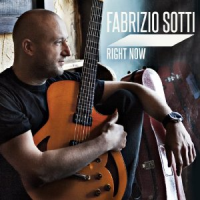 Fabrizio Sotti
Fabrizio Sotti Right Now
Sotti Entertainment
2013
Right Now consolidates the many different threads that Italian songwriter, guitarist and producer Fabrizio Sotti has explored in his career and weaves them all into a singular, beautiful tapestry. Serving as arranger and producer, he divides Right Now into an even mix of jazzy, reflective originals and soft jazz reflections of songs by Bob Marley, U2 and Jimi Hendrix sung by an international vocal cast. Sotti's supple nylon, classical, acoustic and electric guitars are expertly caressed by bassist Tony Grey and multi-instrumentalist Mino Cinelu, who also steps up to the microphone on "Paradis."
Right Now is the complete opposite of bombastic, but its resounding brilliance rings quite loudly. In "One" (U2), the sharp if not acrid edge of Isabella Lundgren's voice combines with her languid phrasing to legitimately suggest Billie Holiday, as Sotti's soft, liquid guitar adorns her sound in jazz and blues. In addition, Zucchero gives sadly beautiful voice to Bono's lyric for "Someone Else's Tears." This genuine and profound reminder of all the terrible beauty and glorious pain in creation may be a difficult song for your ears to leave behind. "In Europe, Zucchero is like Bruce Springsteen," Sotti explains. "The duet he did with Miles, 'Dune Mosse,' blew me away. Seeing an Italian singer with my jazz idol always stayed on my mind. I reached out to Zucchero when I was doing this album and he suggested we do 'Someone Else's Tears.' It was a huge honor to say the least."
Rappers Shaggy and Res rough up "Waiting in Vain" (Bob Marley), and Shaggy's gruff voice provides a great contrasting texture against Sotti's elegant guitar, sandpaper tearing against satin, especially his mid-song toast. (The digital version of Right Now includes the bonus cut "The Wall" featuring Res, Ice-T and M-1.)
Sotti and Cinelu collaborate on "Paradis," with Cinelu's French vocal hovering over the drums and Sotti's jazz guitar as gently as a spring rainshower. Sotti's acoustic guitar and Cinelu's whispering brushes melt into pools of soft rhythm behind Claudia Acuna in "Fidjo Maguado": Cinelu's drums are as tastefully wonderful—in every way—as Dom Um Romao's legendary, impeccable performance on Francis Albert Sinatra / Antonio Carlos Jobim.
The closing title track is precisely the perfect way to end a beautiful release like this—two flickering minutes of reflective solo acoustic guitar (with no words) that sings both welcome and farewell. "I want people to immerse themselves in a peaceful journey when they hear this album and try to enjoy living in the moment," Sotti suggests. "I'm hoping everyone can join me there Right Now."
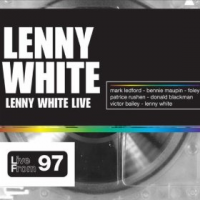 Lenny White
Lenny White Lenny White Live from '97
BFM Jazz
2013
Lenny White played powerful funky drums on some of the best records in jazz and jazz fusion history, including Freddie Hubbard's triumphant Red Clay with Creed Taylor (CTI, 1970), Miles Davis' (in)famous Bitches Brew (Columbia, 1970), Romantic Warrior (Columbia, 1975) from his tenure in the Return to Forever rhythm section, and more.
Lenny White Live from '97 captures the drummer leading a first-call cast of electric and fusion jazz players through a thoroughly magical night during White's Japanese tour in support of his two previous studio albums, Present Tense (HipBop, 1995) and Renderers of Spirit (HipBop Essense, 1996). "The personnel alone is a hint at the quality of music," wrote White's funk co-conspirator and bassist Victor Bailey, who also played in Weather Report. His point is well taken: While White and Bailey stoke up the rhythm engines, the frontline features White's fellow Miles alumni Bennie Maupin (saxophones) and Foley (lead bass), synthesizer player Donald Blackman (from White's Twennynine band), pianist Patrice Rushen and trumpeter-vocalist Mark Ledford (who suffered a fatal heart attack in November 2004).
From the opening version of "Whew! What a Dream" through the encore version which closes this set, White rocks such big fat hard bass and snare drum sounds that everything he plays sounds funky—a sound he shares with John Bonham of Led Zeppelin, who is otherwise a completely different type of drummer. Two bassists—Bailey on rhythm, Foley on lead—plus White's heavy thumping transform "Dark" into a fire-breathing stomping dragon of psychedelic funk, and make Live from '97 a deliciously bottom-heavy set.
But it's more than a raging funk monster. "East St. Louis," six minutes on Present Tense, expands to more than twenty here. After a duet with Bailey, White slips the band into a jazzy groove, which Ledford's trumpet stabs and gores like one of St. Louis' most famous homegrown talents, Miles Davis. "Wolfbane" adds multiple, unison horns to a frantic but colorful fusion melody, and brings the house down with White's closing solo, which sounds like Bonham and Buddy Rich simultaneously discovering the same style.
Patrice Rushen's magnificent playing—in "Whew!," Bailey's "Pic Pocket" and "Wolfbane"—was an absolute revelation for me. I knew Rushen is a great musician; I did not know that she is a great jazz musician.
"My biggest impression of this great record is that while you may have heard all of us before, you've never heard us sound exactly like this. That's chemistry," Bailey's notes continue. "This is a great example of something Lenny and I discuss often, which is FUSION. This is our fusion. Not a million notes, not showing off how much chops we have, but 'fusing' our jazz knowledge and contemporary music knowledge together to create GREAT MUSIC."
"Many special musical moments are only memories for those fortunate enough to have witnessed the live event," wrote White. "We all thought this was special and now we share it with you."
Tracks and Personnel:
Hurricane Season in Brooklyn
Tracks: Free; Hurricane Season in Brooklyn; Let the Music Play; I Can't Wait; Dance Hall Days; Just a Day; The Hippie Don' Know; Money Street Rain; Moments Combine.
Personnel: Amon: percussion, tambourine, steps, claps, glockenspiel, bells, cheeky organ; Sean "Tricky" Dixon: drum kit; B. Satz: bass; Ethan White: piano, electric piano, organ, Hammond organ, synthesizer, synth bass, Juno 60, Wurlitzer, vox synthesizer; Cecilia Stalin: vocals; Dave "Smoota" Smith: trombone; Will Jones: tenor saxophone, baritone saxophone; Jonathan Powell: trumpet, valve trombone; Mark "Tewar" Tewarson: guitar, bass; Scott Kettner: drum kit, bells; Jordan Scannella: bass; John Natchez: tenor saxophone, baritone saxophone; Ezra Brown: tenor saxophone, baritone saxophone; Jkriv: bass.
BoB: a palindrome
Tracks: 3 for Lawrence; Picked from Nick; Big Queen; Tigers on Venus; Middle Passage Suite Part I—For Those of Us Who Made It; Part II—For Those of Us That Didn't Make It; Part III—For Those of Us Still Here; Little Queen; Indiscreet in da Street; Jamming—a.k.a. Ichabod.
Personnel: Robert Hurst: acoustic bass; Branford Marsalis: tenor saxophone, soprano saxophone; Jeff "Tain" Watts: drums; Marcus Belgrave: trumpet, flugelhorn; Adam Rudolph: percussion; Bennie Maupin: alto flute, bass clarinet, tenor saxophone, soprano saxophone; Robert Glasper: acoustic piano, Rhodes.
Dictionary 2
Tracks: Paradox; Stravinsky (with Bach intro); Future; Don Juan; Bilker 3; Etude Indienne; Miles Away; Transparansi.
Personnel: Adi Darmawan: bass, piano; Agam Hamzah: guitar; Gusti Hendi: drums, percussion.
Inspiration Information / Wings of Love
Tracks: CD1 (Inspiration Information): Inspiration Information; Island Letter; Sparkle City; Aht Uh Mi Hed; Happy House; Rainy Day; XL-30; Pling!; Not Available; Miss Pretty; Magic; Things We Like to Do; Castle Top Jam. CD2 (Wings of Love): Intro; Special; Give Me Something Good; Tryin' to Get Close to You; Walkin' Down the Country; Doin' What's Right; Wings of Love; Give me a Chance; Don't You Run Away; Fireball of Love; Fawn; If You'd Be Mine; Black Belt Sheriff; Destination You!
Personnel: Shuggie Otis: guitars, bass, organ, piano, vibes, drums, percussion, vocals; Jack Kelso: saxophones and flutes (CD1); Curt Sletten: trumpet (CD1); Ron Robbins: trumpet (CD1); Doug Wintz: trombone (CD1); Jim Prindle: trombone (CD1); Jeff Martinez: French horn (CD1); Carol Robbins: harp (CD1). Wings of Love: Shuggie Otis: all instruments and vocals.
Right Now
Tracks: One; Waiting in Vain; Paradis; Someone Else's Tears; The Wind Cries Mary; While the Sun is Rising; Prancing Horse; Fidjo Maguado; Fall with Me; Once in a Blue Moon; Right Now; The Wall (digital only).
Personnel: Fabrizio Sotti: electric guitar, acoustic guitar, classical guitar, nylon string guitar; Isabella Lundgren: vocals; Tony Grey: bass; Mino Cinelu: drums, percussion, vocals; Shaggy: vocals; Res: vocals; Zucchero: vocals; Melanie Fiona: vocals; Claudia Acunia: vocals; Algebra Blessett: vocals.
Lenny White Live
Tracks: Whew! What a Dream; East St. Louis; Pic Pocket; Dark; Wolfbane; Whew! What a Dream (alternate).
Personnel: Lenny White: drums; Mark Ledford: trumpet; Bennie Maupin: saxophones; Foley: lead bass; Patrice Rushen: keyboards; Donald Blackman: keyboards; Victor Bailey: rhythm bass.
< Previous
Duke at the Roadhouse: Live in Santa Fe
Next >
From The Hip
Comments
Tags
From the Inside Out
Chris M. Slawecki
United States
Jonathan Powell
Miles Davis
Thievery Corporation
Ella Fitzgerald
Chaka Khan
Eddie Harris
Ron Carter
Paul Chambers
Doug Watkins
Marcus Belgrave
Ray Charles
Jeff "Tain" Watts
wynton marsalis
Branford
Willie Nelson
Barbra Streisand
Chris Botti
Diana Krall
Robert Glasper
Adam Rudolph
BENNIE MAUPIN
duke ellington
Alice Coltrane
Pharoah Sanders
Charles Mingus
James Brown
Robert Fripp
Bill Bruford
King Crimson
john mclaughlin
jeff beck
Johnny Otis
Charles Brown
Esther Phillips
Al Kooper
Quincy Jones
Etta James
Frank Zappa
Bobby Womack
Creed Taylor
Wes Montgomery
War
bob marley
U2
Jimi Hendrix
Tony Grey
Mino Cinelu
Billie Holiday
Zucchero
Bruce Springsteen
Claudia Acuna
Dom Um Romao
Antonio Carlos Jobim
Freddie Hubbard
Return To Forever
Victor Bailey
Weather Report
Foley
Patrice Rushen
Led Zeppelin
Buddy Rich
For the Love of Jazz
 All About Jazz has been a pillar of jazz since 1995, championing it as an art form and, more importantly, supporting the musicians who create it. Our enduring commitment has made "AAJ" one of the most culturally important websites of its kind, read by hundreds of thousands of fans, musicians and industry figures every month.
All About Jazz has been a pillar of jazz since 1995, championing it as an art form and, more importantly, supporting the musicians who create it. Our enduring commitment has made "AAJ" one of the most culturally important websites of its kind, read by hundreds of thousands of fans, musicians and industry figures every month.






